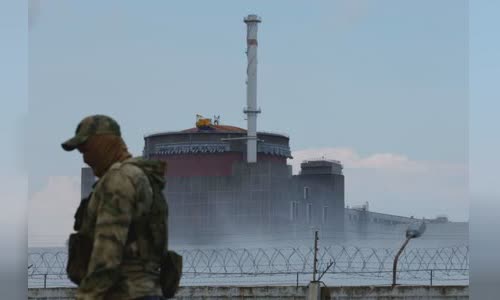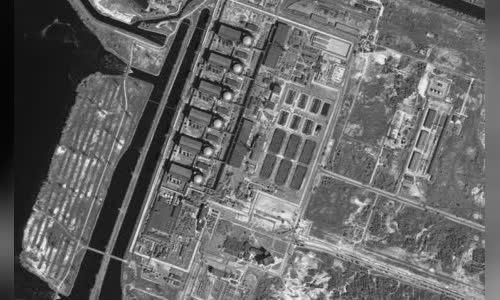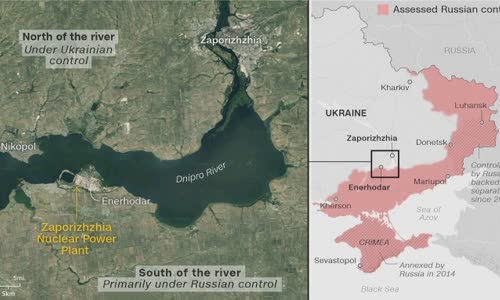The fighting around the Zaporizhzhia power plant in Ukraine recently continued to raise concerns about a serious nuclear disaster.
Any potential damage to Zaporizhzhia nuclear factory is suicide, UN Secretary General Antonio Guterres said on August 18 in a meeting with Turkish President Recep Tayyip Erdogan and Ukraine President Volodymyr Zelensky

Photo: Reuters
Turkish President Erdogan also announced that we did not want another Chernobyl, referring to the 1986 nuclear disaster in Pripyat, Ukraine.
The urgent warnings came when fighting around the Zaporizhzhia nuclear power plant area in Zaporizhzhia province controlled by Russia in southern Ukraine.
Russian soldiers stood near the Zaporizhzhia nuclear power plant, southeastern Ukraine on August 4.
Nuclear energy provides 55% of Ukraine's electricity in 2021, with 15 reactors at 4 different power plants.
Since March, the factory is under the control of the Russian forces, but has been operated by Energoatom technicians, Ukraine National Nuclear Energy Group.
Energoatom said that Russia plans to connect the factory to the crimea peninsula, where Moscow merged in 2014. Located about 200 km from Crimea, the factory has 6 reactors, enough to supply electricity for 4 million households
Russia is said to have deployed 500 soldiers and arranged rocket launchers in the premises of the nuclear power plant.
Vladimir Rogov, a member of the regional government, said the factory had to reduce production and could stop production if the artillery continued.
Ukraine probably understood the consequences of explosions and fire at a nuclear power plant than any country.

Photo: Reuters
The incident had a big impact on Ukraine, with about 350,000 people evacuated and more than 600,000 people registered as emergency staff and restored.
Although Zaporizhzhia uses enriched uranium, the factory's current water energy reactors are not slowed with graphite but with water, which means they are safer and it will be difficult to occur in the way of chernobyl.
In addition, Ukraine's modern reactors, such as at Zaporizhzhia factory, are also protected by a solid secondary concrete blocker system, designed to withstand explosions or one units.
Any radioactive incident is an obsession with many people.
Radioactive expert Boris Zhuikov has shared that it is very difficult to have a disaster that is more difficult than Chernobyl, because the design of two different types of reactors.
It is difficult to destroy the reactor even when intentionally, unless it is constantly shelling in the same point.
Andrrei Ozharovsky, a radioactive waste safety expert at the Russian Social - Ecological Union, said that a missile attack, whether accidentally or intentionally, could lead to an explosion in the reactor.
If the reactor explodes, due to the location of the Zaporizhzhia factory located near the Dnipro River, radioactivity is likely to affect hundreds of kilometers around, Ozharovsky said.
Overview of Zaporizhia nuclear power plant, southeastern Ukraine.

Photo: CNN
Zhuikov expert said the incident size will depend on many factors like how it occurs, the reaction of the factory staff and the speed of evacuation of residents.
The question is not whether radioactive is spread into the air and water source.
Observers also warned that radioactive clouds can spread to neighboring countries of Ukraine depending on the wind direction.
What more experts worry is that artillery shells can hit the nuclear waste storage store stored in Zaporizhzhia.
Radioactive waste at Zaporizhzhia is stored in special lakes, where used nuclear fuels are soaked in water to cool and reduce radiation concentration before being transferred to the final storage place.
In the case of a shells that broke the wall surrounding the lake, causing the cooling water to leak, the fuel stored in the lake will heat up.
Ukraine earlier this month warned the factory to store 1,200 tons of nuclear fuel, and said the risk of radioactive pollution could be very high if the explosion occurs.
More than 40 countries have called for Russia to withdraw forces and allow the International Atomic Energy Agency (IAEA) to check the factory.
I ask both sides of the conflict to cooperate with IAEA and allow the Single Team to go to Zaporizhzhia nuclear factory as soon as possible.
The location of the Dnipro river area and Zaporizhzhia nuclear power plant in southeastern Ukraine.



 Michele Daniels
Michele Daniels







